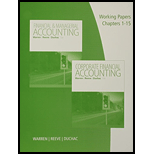
Working Papers, Volume 1, Chapters 1-15 for Warren/Reeve/Duchac's Corporate Financial Accounting, 13th + Financial & Managerial Accounting, 13th
13th Edition
ISBN: 9781285869582
Author: Carl Warren, James M. Reeve, Jonathan Duchac
Publisher: Cengage Learning
expand_more
expand_more
format_list_bulleted
Concept explainers
Question
Chapter 23, Problem 1DQ
To determine
Centralized operations: In a company where the major plans and operating decisions are controlled by the top level management, such a company is said to have centralized operations.
Decentralized operations: In a company where the plans and operating decisions are delegated to the divisional managers, such a company is said to have decentralized operations.
To distinguish: Centralized operations from decentralized operations
Expert Solution & Answer
Explanation of Solution
Differences between centralized and decentralized operations:
| Centralized Operations | Decentralized Operations |
| The major operating decisions are controlled by top level management. | The major operating decisions are delegated to divisional managers. |
| Centralized operations are preferable by small businesses, where one man can handle all the operations. | Decentralized operations are delegated to the managers with expertise in the respective production lines and services. |
| Since the business is small and can be controlled by one person, it is easy to maintain the operations, and not much experience is necessary. | Since the product lines and numerous, top level management cannot alone control all the operations, and may not have expertise in all departments. |
Table (1)
Want to see more full solutions like this?
Subscribe now to access step-by-step solutions to millions of textbook problems written by subject matter experts!
Students have asked these similar questions
Please provide the correct answer to this general accounting problem using valid calculations.
Can you solve this general accounting question with the appropriate accounting analysis techniques?
None
Chapter 23 Solutions
Working Papers, Volume 1, Chapters 1-15 for Warren/Reeve/Duchac's Corporate Financial Accounting, 13th + Financial & Managerial Accounting, 13th
Ch. 23 - Prob. 1DQCh. 23 - Differentiate between a profit center and an...Ch. 23 - Weyerhaeuser developed a system that assigns...Ch. 23 - What is the major shortcoming of using income from...Ch. 23 - In a decentralized company in which the divisions...Ch. 23 - How does using the return on investment facilitate...Ch. 23 - Why would a firm use a balanced scorecard in...Ch. 23 - Prob. 8DQCh. 23 - When is the negotiated price approach preferred...Ch. 23 - When using the negotiated price approach to...
Ch. 23 - Prob. 23.1APECh. 23 - Prob. 23.1BPECh. 23 - Service department charges The centralized...Ch. 23 - Service department charges The centralized...Ch. 23 - Income from operations for profit center Using the...Ch. 23 - Prob. 23.3BPECh. 23 - Prob. 23.4APECh. 23 - Profit margin, investment turnover, and ROI Briggs...Ch. 23 - Residual income The Consumer Division of Hernandez...Ch. 23 - Prob. 23.5BPECh. 23 - Transfer pricing The materials used by tile North...Ch. 23 - Transfer pricing The materials used by the...Ch. 23 - Budget performance reports for cost centers...Ch. 23 - Divisional income statements The following data...Ch. 23 - Service department charges and activity bases For...Ch. 23 - Prob. 23.4EXCh. 23 - Service department charges In divisional income...Ch. 23 - Service department charges and activity bases...Ch. 23 - Divisional income statements with service...Ch. 23 - Prob. 23.8EXCh. 23 - Prob. 23.9EXCh. 23 - Rate of return on investment The income from...Ch. 23 - Residual income Based on the data in Exercise...Ch. 23 - Determining missing items in return on investment...Ch. 23 - Prob. 23.13EXCh. 23 - Prob. 23.14EXCh. 23 - Prob. 23.15EXCh. 23 - Determining missing items from computations Data...Ch. 23 - Prob. 23.17EXCh. 23 - Prob. 23.18EXCh. 23 - Building a balanced scorecard Hit-n-Run Inc. owns...Ch. 23 - Decision on transfer pricing Materials used by the...Ch. 23 - Prob. 23.21EXCh. 23 - Budget performance report for a cost center...Ch. 23 - Prob. 23.2APRCh. 23 - Divisional income statements and rate of return on...Ch. 23 - Effect of proposals on divisional performance A...Ch. 23 - Prob. 23.5APRCh. 23 - Prob. 23.6APRCh. 23 - Prob. 23.1BPRCh. 23 - Prob. 23.2BPRCh. 23 - Prob. 23.3BPRCh. 23 - Prob. 23.4BPRCh. 23 - Prob. 23.5BPRCh. 23 - Prob. 23.6BPRCh. 23 - Prob. 23.1CPCh. 23 - Prob. 23.2CPCh. 23 - Evaluating divisional performance The three...Ch. 23 - Evaluating division performance over time The...Ch. 23 - Evaluating division performance Last Resort...
Knowledge Booster
Learn more about
Need a deep-dive on the concept behind this application? Look no further. Learn more about this topic, accounting and related others by exploring similar questions and additional content below.Similar questions
- Can you solve this general accounting problem using appropriate accounting principles?arrow_forwardPlease provide the correct answer to this general accounting problem using valid calculations.arrow_forwardPlease explain the solution to this general accounting problem using the correct accounting principles.arrow_forward
- Please explain the solution to this general accounting problem with accurate principles.arrow_forwardPlease explain the solution to this general accounting problem with accurate principles.arrow_forwardPlease provide the answer to this general accounting question using the right approach.arrow_forward
- Please help me solve this general accounting question using the right accounting principles.arrow_forwardCan you solve this financial accounting question with accurate accounting calculations?arrow_forwardI am trying to find the accurate solution to this general accounting problem with the correct explanation.arrow_forward
arrow_back_ios
SEE MORE QUESTIONS
arrow_forward_ios
Recommended textbooks for you
 Managerial AccountingAccountingISBN:9781337912020Author:Carl Warren, Ph.d. Cma William B. TaylerPublisher:South-Western College Pub
Managerial AccountingAccountingISBN:9781337912020Author:Carl Warren, Ph.d. Cma William B. TaylerPublisher:South-Western College Pub Accounting Information SystemsAccountingISBN:9781337619202Author:Hall, James A.Publisher:Cengage Learning,Principles of Accounting Volume 2AccountingISBN:9781947172609Author:OpenStaxPublisher:OpenStax College
Accounting Information SystemsAccountingISBN:9781337619202Author:Hall, James A.Publisher:Cengage Learning,Principles of Accounting Volume 2AccountingISBN:9781947172609Author:OpenStaxPublisher:OpenStax College Cornerstones of Cost Management (Cornerstones Ser...AccountingISBN:9781305970663Author:Don R. Hansen, Maryanne M. MowenPublisher:Cengage Learning
Cornerstones of Cost Management (Cornerstones Ser...AccountingISBN:9781305970663Author:Don R. Hansen, Maryanne M. MowenPublisher:Cengage Learning

Managerial Accounting
Accounting
ISBN:9781337912020
Author:Carl Warren, Ph.d. Cma William B. Tayler
Publisher:South-Western College Pub

Accounting Information Systems
Accounting
ISBN:9781337619202
Author:Hall, James A.
Publisher:Cengage Learning,

Principles of Accounting Volume 2
Accounting
ISBN:9781947172609
Author:OpenStax
Publisher:OpenStax College

Cornerstones of Cost Management (Cornerstones Ser...
Accounting
ISBN:9781305970663
Author:Don R. Hansen, Maryanne M. Mowen
Publisher:Cengage Learning